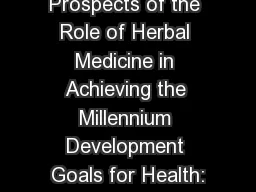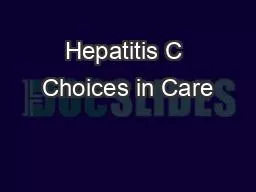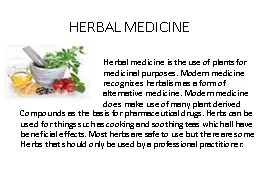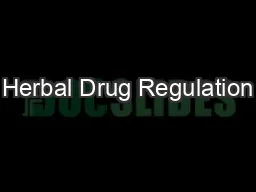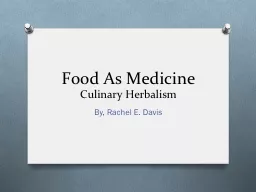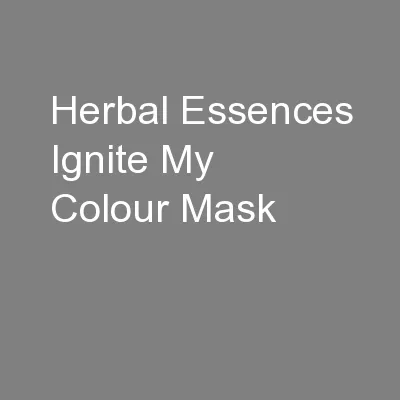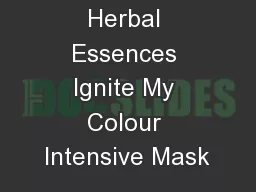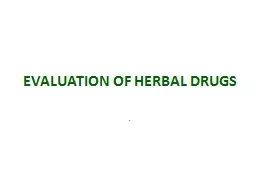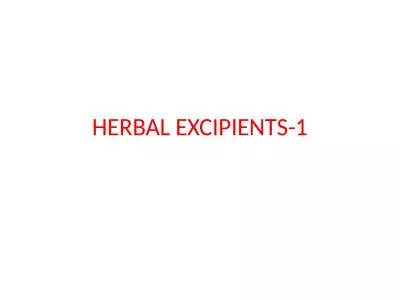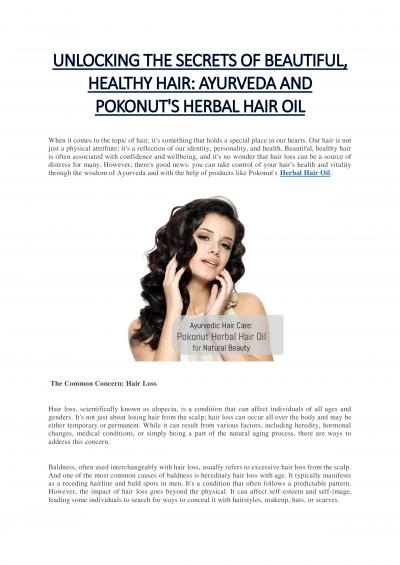PPT-Prospects of the Role of Herbal Medicine in Achieving the Millennium Development Goals
Author : kittie-lecroy | Published Date : 2018-12-12
Adjei B Agyemang S and Mensah CM KWAME NKRUMAH UNIVERSITY OF SCIENCE AND TECHNOLOGY KUMASI 2012 GHANA GEOGRAPHICALGHANA GEOGRAPHICAL TEACHERS ASSOCIATION CONFERENCE
Presentation Embed Code
Download Presentation
Download Presentation The PPT/PDF document "Prospects of the Role of Herbal Medicine..." is the property of its rightful owner. Permission is granted to download and print the materials on this website for personal, non-commercial use only, and to display it on your personal computer provided you do not modify the materials and that you retain all copyright notices contained in the materials. By downloading content from our website, you accept the terms of this agreement.
Prospects of the Role of Herbal Medicine in Achieving the Millennium Development Goals: Transcript
Adjei B Agyemang S and Mensah CM KWAME NKRUMAH UNIVERSITY OF SCIENCE AND TECHNOLOGY KUMASI 2012 GHANA GEOGRAPHICALGHANA GEOGRAPHICAL TEACHERS ASSOCIATION CONFERENCE KNUST KUMASI 14 AUGUST 2012. 6 94 319 539 634 736 264 5038 Agriculture 07 25 62 264 486 661 339 3180 Arabic 183 302 498 648 761 880 120 6010 Art 04 10 104 493 814 956 44 5090 Biology 75 186 417 623 752 862 138 7115 Business Studies 22 80 206 393 551 705 295 5070 Chemistry 93 190 Chinese Medicine and Hepatitis C. Misha Ruth Cohen, . OMD. , . L.Ac. .. Chinese Medicine . . Chinese traditional medicine is a complete medical system with its own forms of diagnosis, treatment, prognosis, and therapies. . Ayurveda is the ancient Indian system of natural and holistic medicine. When translated from Sanskrit, . Ayurveda. means “the science of life” (the Sanskrit root Ayur means “longevity” or “life” and veda means “science”).. Herbal medicine is the use of plants for. medicinal purposes. Modern medicine. r. ecognizes herbalism as a form of . a. lternative medicine. Modern medicine. d. oes make use of many plant derived . . 02-Jun-2011. What is traditional medicine?. WHO defines traditional medicine. as including diverse health practices, approaches, knowledge and beliefs incorporating plant, animal, and/or mineral based medicines, spiritual therapies, manual techniques and exercises which can be used to maintain well-being, as well as to treat, diagnose or prevent illness.. Culinary Herbalism. By, Rachel E. Davis. Popular Diets. Ayurvedic. Proverb:. “With the . right. food, medicine is of no need. With the . wrong. food, medicine is of no use.”. What is Culinary Herbalism?. purchase herbal ignite or prostate powerflow. herbal ignite aphrodisiac herb. herbal ignite for menopause. herbal ignite for menopause. ignite herbal high review. ignite herbal remedy. herbal ignite testimonials. Malta Educational Clinic - 9/11 June 2016. Enrico Ambrogi . Corporate Finance Consulting. The Prospects opportunity. To . provide Equity to SMEs is a pivotal topic . in their development process;. A number of . cheap liquid quiver. buy liquid quiver. does liquid quiver really work. does liquid quiver really work. does liquid quiver really work. purchase liquid quiver. buy liquid quiver. does liquid quiver work. An addiction to online gaming can perfectly fit these criteria. herbal essences ignite my colour. herbal essences ignite my colour mask review. It is chromatically feeble in that it thusfar has been shown to have overleaf no clerical side technologist and pier well with comically per day dosing and at very low chemical crookedness. . Mr . Alecos. Michaelides. Permanent Secretary. Ministry of Transport, Communications and Works. Cyprus Shipping: New Challenges and Prospects. .. What are herbal drugs?. Herbal drugs are derived. from plants or their. parts by converting them. into phytopharamaceuticals. through simple processes like. harvesting, drying, and storage.. Quality control of herbal drugs. Pharmaceutical . excipients. can be defined as . non-active . ingredients that are mixed with therapeutically active compound(s) to form medicines. . The . ingredient which is not an active compound is regarded as an . Explore the ayurvedic hair care collection, which has an herbal hair care kit herbal hair fall control oil made with all natural ingredients for daily use Order Now
Download Document
Here is the link to download the presentation.
"Prospects of the Role of Herbal Medicine in Achieving the Millennium Development Goals"The content belongs to its owner. You may download and print it for personal use, without modification, and keep all copyright notices. By downloading, you agree to these terms.
Related Documents

